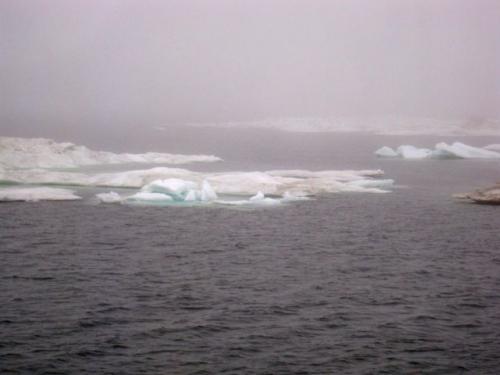When research ships are at sea, it’s never easy to pinpoint exact times such as port arrival and departure, times when the ship will arrive at a station, or how long it will stay at a station. A station is a specific location where the ship stops so the science teams on board can do their sampling. Although the Khromov was scheduled to arrive at the dock at 4 PM on Monday the 27th, we could see it there by noon. After several hours of waiting for the ship to clear customs, most of the science team moved on board and some even loaded equipment. On Tuesday, Jackie, Monica Kedra, Jackie’s postdoctoral student, and I moved several boxes of equipment and gear on board the ship and waited to hear what time we would leave the dock. With the possibility of bad weather, departure times ranged from just after noon on Tuesday to early the following morning.

Following the announcement that high winds were expected and the ship would move off the dock at 7 PM, everyone on board worked hard to get all gear loaded, unpacked, stowed, and well secured before turning in for the night. With nearly 50 scientists and support personnel on board, space is at a premium and everyone worked hard to compromise; no one has an ideal space, but everyone seems to have what they need. Those with less to unpack and set up were able to turn in at a reasonable hour. Monica and I were finished just after midnight (although Jackie was still working), but others worked well into the early morning hours.
By Wednesday morning, we were well on our way, and the storm had passed us by. Following breakfast, we all attended the mandatory safety lesson and drill, including moving to our “muster station” and getting into the crowded lifeboats. A post lunch meeting included introductions of all in the science teams and a discussion of which areas to sample in order to make best use of the ship´s time. At all general meetings, one person speaks and she/he is followed by a repeat of the information in Russian given by Alexey Ostrovskiy. Trained as a geophysicist in Russia, Alexey also spent 6 years in Washington DC as science liaison at the Russian embassy. With his excellent English, he translates easily so everyone on board is well informed.
In the early afternoon, everyone on board felt several large bumps as the ship hit the first ice we’ve seen. No matter how many times I see the ice, it’s always exciting! A short time later we heard an announcement that several walrus had been sighted on both sides of the ship and that we had crossed the Arctic Circle.
The current schedule includes an early station to test the CTDA research tool that is submerged in the water to measure conductivity (salinity), temperature, and depth. (I’ll tell you more later) and a full biological station to start at approximately midnight. Jackie, Monica and I will start working right after dinner in order to be ready to start sampling. The first station is always a long one as everyone gets into a routine – who samples when, how much and how long, and who works in what space. I’ll write about that station tomorrow.
Note: As I write about different scientists, I’ll try to include pictures of them at work to give you an idea of what they do. To see what each person looks like and to find out more about them, just go to www.oceanexplorer.noaa.gov/explorations/12arctic/welcome/html


Comments